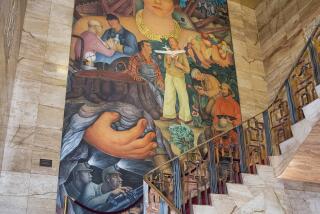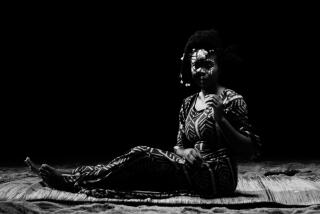BOOK REVIEW / NONFICTION : A Passionate Gaze Into the Mirror of Mythology : ISIS AND OSIRIS: Exploring the Goddess Myth <i> by Jonathan Cott</i> , Doubleday, $23, 209 pages
- Share via
When it comes to dysfunctional families, neither the Oedipus clan nor even the Reagans offer a more intriguing case history than Osiris and Isis, a pair of ancient Egyptian deities who were “not only sister and brother, but also wife and husband, queen and king, goddess and god.”
The story of these star-crossed siblings, as recounted by Jonathan Cott in “Isis and Osiris,” features incestuous love, matricide, dismemberment, anal rape, necrophilia, tragic death and miraculous rebirth. And, as Cott shows us, the myth of Isis and Osiris continues to exert a powerful and almost magical influence on seekers and believers.
“Astonishingly, some five thousand years after the first recorded acknowledgment of her existence,” Cott writes, “the Mother of All and her brother/husband/consort are still being worshiped today in many countries of the world.”
Cott introduces us to Isis and Osiris by recounting their story in solemn, measured, almost sacral tones--but the story itself is so full of strange passion that the narrative almost catches fire. Indeed, Cott’s book shows us exactly why the old myth is so enduring and so beguiling.
Osiris and Isis are twins who fell in love in their mother’s womb and grew up as “a couple whose love passed understanding.” But a jealous brother murdered Osiris and sliced his body into 14 pieces. The grieving Isis summoned her dead lover from beyond the grave to impregnate her with the child who will be “his son, heir and avenger.” And thus Isis and Osiris achieve a kind of immortality, and their myth offers “the promise of eternal life and resurrection.”
“I am life rushing on,” declares Horus, the child of their mystical union, “born from the egg of the world, from the belly of a magic woman, born of my father’s dreams. . . . A man forgets, but his heart remembers--the love and the terror, the weeping, the beating of wings.”
The tale of Isis and Osiris is virtually an encyclopedia of mythic imagery, and so we are hardly surprised when Cott argues that its meanings can be traced into such far-flung spiritual manifestations as the passion of Christ and the doctrine of chakras in the Kundalini system of yoga.
“Except for who knows what vagaries,” observes curator Robert S. Bianchi, “we in the West might today be Isis devotees instead of Jews, Christians or Muslims.”
Indeed, much of “Isis and Osiris” is an account of Cott’s quest for the linkages between the ancient Egyptian myth and its renaissance in the contemporary world. Along the way, Cott introduces us to the sages who study Isis and Osiris--and, more to the point, the seekers who continue to venerate them. At the heart of the now-fashionable “goddess worship,” Cott suggests, is the enduring figure of Isis: “Mother of All, Ruler of the Elements, Progenitor of Worlds, Chief of All Deities.”
The adepts and aficionados whom Cott profiles in “Isis and Osiris” range from dispassionate scholars to wildly inventive psychotherapists to self-styled arch-priestesses. They perceive and interpret Isis and Osiris in starkly different ways, but all of them are drawn to the exotic light of their myth.
For example, James P. Allen, a curator of Egyptian art at the Metropolitan Museum of Modern Art, argues that the god myths of ancient Egypt are the functional equivalent of our concepts of quantum physics, a way of explaining the world to ourselves in sometimes richly metaphorical language.
“Those who worship Isis and Osiris have simply singled out one aspect (of ancient Egyptian religion) to identify with,” Allen says, “although to me, it’s the same as worshiping electromagneticism or gravity.”
By contrast, Cott finds his way to a hidden community of so-called Ammonites in Cairo who submit themselves to the “Forty-two Laws of the Saints” drawn from the Book of the Dead and worship the pantheon of ancient Egyptian gods, including Isis and Osiris.
“Since the days of the first Ammonite kingdoms outside Egypt, we’ve been wandering as freaks of the earth,” says the mysterious woman who claims to occupy the Lotus Throne of the Pharaoh and who regards her 9-year-old son as a living incarnation of Horus, the offspring of Isis and Osiris, “but by being freaks we have kept the seed of truth alive.”
At moments, the Isis worshipers come across as charming eccentrics. For example, we spend a good deal of time in the company of a brother-and-sister team who preside over the so-called Fellowship of Isis at Clonegal Castle in Ireland--but Isis is only one of the passions of “archpriestess and hierophant” Olivia Robertson, a ripping good raconteur who also believes in UFOs, reincarnation and ghosts, and who says she was once visited by Mary Magdalene: “She had a face like Vanessa Redgrave’s,” Olivia recalls.
But, mostly, Cott appears to take his subject quite seriously. He’s an accomplished chronicler of myth and legend whose work has appeared in journals as diverse as Rolling Stone and Parabola, and he approaches his subject with both a subtle sense of humor and a profound sense of compassion. And he is utterly free of sarcasm and condescension toward the men and women whose zealous beliefs he is exploring.
In fact, at the end of his quest, Cott leaves us with an epiphany of his own that suggests a visitation by Isis herself.
“Adorned with every star of heaven/mirror on your forehead/serpents by your side,” goes the poem that Cott wrote to capture his dreamy encounter with the goddess, “one breathes your perfumed air/through nights of sweetest sleep/until your mirror becomes the sun. . . .”
More to Read
Sign up for our Book Club newsletter
Get the latest news, events and more from the Los Angeles Times Book Club, and help us get L.A. reading and talking.
You may occasionally receive promotional content from the Los Angeles Times.









